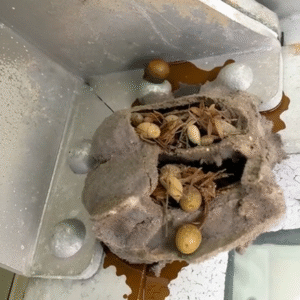In modern kitchens, efficiency and aesthetics often collide. When organizing a kitchen, it can feel natural to leave your most-used items out in the open — bread, fruits, spice jars, knives, coffee makers, and more — within arm’s reach. This logic, driven by convenience and visibility, often convinces homeowners that keeping frequently used kitchen essentials on the countertop is the smartest move.
I used to believe that myself. When I first arranged my kitchen, accessibility was my top priority. Everything I needed regularly was left out where I could see it: appliances ready to go, fruits in bowls, bread in easy reach, spices in arm’s length. It felt functional. It looked lived-in. And at first, it seemed like the perfect setup.
But over time, I realized this “open-access” system was creating far more problems than it solved.
The Downsides of Cluttered Countertops
What began as an efficient setup quickly turned into visual chaos. The countertops became increasingly cluttered. The kitchen, which was meant to feel open and inspiring, started to feel crowded and overwhelming. I hadn’t anticipated how much visual noise could affect my ability to focus or enjoy cooking. It wasn’t just about physical mess — the clutter was draining mental energy too.
Then came the hygiene issues.
Food left out in the open—especially items like bread and fruit—became a magnet for dust, moisture, sunlight, and bacteria. Fruit spoiled faster under direct light. Bread went stale within days. Knives and small appliances gathered grime that was hard to notice but hard to clean once it set in. I realized I wasn’t just compromising aesthetics; I was undermining cleanliness, health, and shelf life.
Even worse, I found myself damaging my kitchen gear and ingredients without meaning to. Prolonged exposure to air, grease, and temperature shifts degraded appliances and spoiled food. My kitchen wasn’t streamlined—it was slowly falling apart.
That’s when I knew it was time for a change. I needed a smarter strategy for what belonged on the countertop and what didn’t.
If you’ve ever wondered why your kitchen feels cluttered, messy, or hard to clean despite your best efforts, chances are you’re storing things on your counters that don’t belong there. Here are 10 things you should never leave on your kitchen countertops—and why clearing them away can completely transform your space.
- Bread
Bread may seem harmless on the counter, but exposure to heat and air causes it to go stale faster. If you’re storing bread in its original plastic or paper bag on the counter, expect a much shorter shelf life. Opt instead for a bread box with proper ventilation or freeze unused portions to preserve freshness.
- Fresh Fruit
Fruits look attractive in a bowl on the counter, but it’s not ideal for longevity. Many fruits, especially ones like bananas, apples, or citrus, emit ethylene gas, which accelerates ripening (and spoilage) when clustered. Direct sunlight also degrades them quickly. Use the fridge when appropriate, and rotate fruit daily to prevent waste.
- Spices
Spices stored near heat sources like stoves or left out in the open lose their potency faster. Heat and light break down essential oils and flavor compounds. Transfer spices to a dark drawer or dedicated spice rack inside a cabinet to maintain freshness and taste.
- Knives in Knife Blocks
While knife blocks are a staple in many kitchens, they aren’t always hygienic. Moisture can become trapped inside the block, creating a breeding ground for mold and bacteria. Worse, if the knives are placed in while slightly damp, it compromises both the cleanliness and longevity of the blades. Consider a magnetic wall strip or in-drawer knife holder instead.
- Small Appliances You Rarely Use
Blenders, toasters, mixers, and food processors often sit out “just in case,” but unless you use them daily, they take up valuable real estate and collect dust and grease. Store rarely-used appliances in cabinets or pantries to free up space and reduce cleaning frequency.
- Paper Towels
Many people leave paper towels on the counter for convenience, but this exposes them to kitchen grease and bacteria. Mount a paper towel holder under a cabinet or inside a drawer to keep them clean, dry, and accessible without occupying counter space.
- Cooking Oils
Storing oils on the counter, especially near the stove, may seem smart for convenience—but it’s not ideal for shelf life. Heat and light degrade oil quality, leading to rancidity. Keep oils in a cool, dark cabinet and use small dispensers if you need them handy for everyday cooking.
- Cutting Boards
Leaving cutting boards on the counter invites cross-contamination and encourages mold growth, especially if they’re not fully dry. Store them vertically in a designated rack or cabinet slot where they can air dry thoroughly between uses.
- Mail and Keys
Kitchen counters often double as a drop zone for non-kitchen items like mail, keys, or receipts. But this creates clutter quickly and introduces germs and grime into your food prep area. Create a dedicated catch-all space near the entryway or a wall organizer to keep personal items separate.
- Pet Food Bowls
If your pet’s food and water bowls live on the kitchen counter, it’s time to relocate. Pet food can attract pests, harbor bacteria, and cross-contaminate with your human food prep area. Keep bowls on the floor, cleaned daily, and away from your food surfaces.
The Psychological Impact of a Clutter-Free Kitchen
Beyond hygiene and food preservation, clearing countertops has a significant mental health benefit. A tidy kitchen fosters calm, encourages cooking, and reduces decision fatigue. Every item you leave on the counter is a piece of visual information your brain has to process. Removing that excess noise creates space—physically and mentally.
How to Make the Shift Without Losing Convenience
Downsizing your countertop inventory doesn’t mean sacrificing function. Instead, organize with purpose:
- Use pull-out drawers for spices and utensils.
- Designate a small appliance cabinet with easy access.
- Install under-cabinet shelves for paper towels or dish soap.
- Rotate fruit daily or store it based on ripeness.
- Adopt a “one in, one out” rule to prevent clutter from building up again.
Final Thoughts: Simplicity Creates Space
Clearing your kitchen countertops of unnecessary items does more than make your space look cleaner—it makes it work better. It protects your tools, preserves your ingredients, and clears the mental fog that comes with clutter. Most importantly, it allows you to fully enjoy your kitchen again.
By rethinking how we use our countertops and reassigning storage based on real function—not just convenience—we can build a kitchen that’s efficient, beautiful, and far easier to maintain.
Ready to take your kitchen from chaotic to calm? Start with these ten items, and you’ll feel the difference almost immediately.




